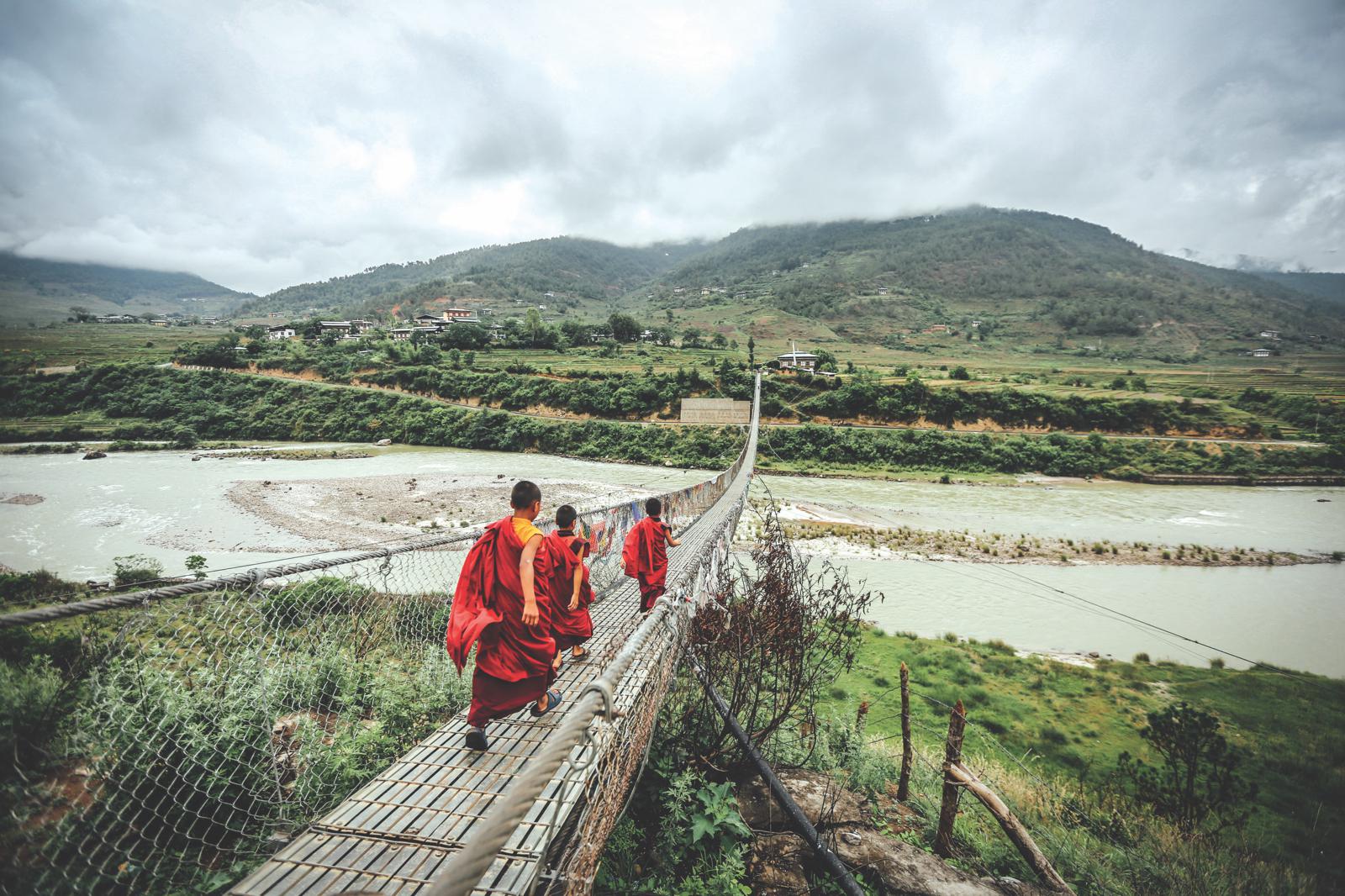Bhutan Art & Culture, Wellness
Bhutan: Kingdom in the Clouds


The small landlocked country of Bhutan may well be one of the world’s last true travel frontiers…
There’s a moment, about halfway up the pine-covered mountains surrounding Paro Taktsang monastery, when I begin to understand why Bhutan is known as The Kingdom in the Clouds.
It’s late spring, and my guide Arya Dew and I have been walking since dawn to avoid the heat of the day. Despite being one of the world’s most significant Buddhist pilgrimage sites, the iconic monastery (also known as Tiger’s Nest) and trail are blissfully quiet at this time of the day – the soft jangle of bells and flapping of prayer flags are the only sounds as we walk.
The track to get to the temple, which clings to cliffs “like a gecko”, as the locals like to say, is steep, long and at a dizzying altitude. But Arya cuts a cracking pace, despite wearing a long gho, a type of traditional robe favoured by Bhutanese men.
For more than a thousand years, this tiny realm, wedged into mountainous folds between India and China, survived in splendid isolation. It remained closed to the outside world – both by geography and deliberate policy – until 1974, when foreign tourists were officially welcomed.
Two years earlier, when King Jigme Singye Wangchuck ascended the throne, an ambitious plan was set not only to improve living standards but to redefine the process of development. He decided the “wealth” of his nation would not be measured by economic growth, but instead by a concept known as Gross National Happiness.
More than 40 years later, three-quarters of the country is still forested, with 25 per cent designated protected areas – among the highest percentages in the world.
Tourism is growing, though strict limits on construction and a nightly, all-inclusive tourist tariff of a minimum US$40 (about A$56) per visitor means that the country avoids the visitor hoards that flock to neighbouring regions.
Before our trek to Paro Taktsang, I check in to the beautiful 29-room COMO Uma Paro, perched on a hill and designed with flared roofs and painted frescoes to resemble the fortress-like temples (dzongs) that dot the countryside.
With my steep pre-dawn climb in mind, I locate the restaurant and promptly order as much food as I can: ema datshi, a mix of smoky chilli peppers and melted yak milk cheese, and a fragrant platter of momo (dumplings) stuffed with wild mushrooms and more cheese.
There’s also a ceramic pot of indigenous firewater called ara, a throat-numbing beverage made from rice, maize, millet or wheat.
An hour’s drive from Paro is Thimphu, one of the world’s only capital cities where there are no traffic lights; cars are orchestrated by a man in a tight-fitting uniform with shiny gold buttons.
We drive around his colourful rotunda on the way to Tashichho Dzong, or the Fortress of Glorious Religion. Constructed in 1216 AD, the sprawling complex of whitewashed buildings with tiered golden roofs is still home to the throne room and offices of the handsome young king, Jigme Khesar Namgyel Wangchuck, the first son of Jigme Singye Wangchuck.
The dzong is within easy reach of Chagri Dorjeden, a working meditation centre set high on a hill. Another sweat-inducing but beautiful walk ensues through a forest of rhododendrons – Bhutan is home to more than 50 species – as well as cypress, orchids and oak, with prayer flags and occasional statues of Buddha along the way. We’re greeted by monks in maroon robes, circumambulating a hall, twirling prayer wheels as they go.
Driving east, the road curves through silvery spruce forests and gorges roaring with waterfalls. We pass long-eyelashed cows, who have right of way here; Indian road workers squatting by fires; women in kira dresses loaded with firewood; and farmhouses with their painted wood lintels.
We stop briefly at the high Dochula Pass, a circular arrangement of 108 white chortens facing a line of snow-capped peaks.
From here, we descend in hairpins through forests of towering blue pine to the lush valley of Punakha.
The first thing you see of the former capital is its grand dzong, set at the confluence of two rivers and known as the Palace of Great Happiness. There’s an atmosphere of calm throughout the complex, with a notable absence of music, voices or machinery.
It’s the same calm I find at COMO Uma Punakha, my luxurious retreat for the night. Modelled on a dzong, the low-slung, 11-room hideaway has an enviable outlook over terraced rice fields, the temple of Khamsum Yuley Namgay and powder-coated Himalayan peaks.
Even the silence has texture here. The pristine natural surroundings and unbroken silence soothe the soul. They offer me reason to pause, and that’s exactly what I do.
For the next day, the outdoor terrace becomes my temporary home – I barely move from this perch, gazing over the fields of emerald, allowing for the occasional distraction to graze on meals made using organic local produce: red rice, hand-ground buckwheat flour, apple cider vinegar, and hand-moulded farm cheese.
The shrillness of the world beyond Bhutan’s borders is clearly yet to pierce this blanket of calm. And I wouldn’t want it any other way.
Latest Articles
Don't miss the latest from Luxury Travel
